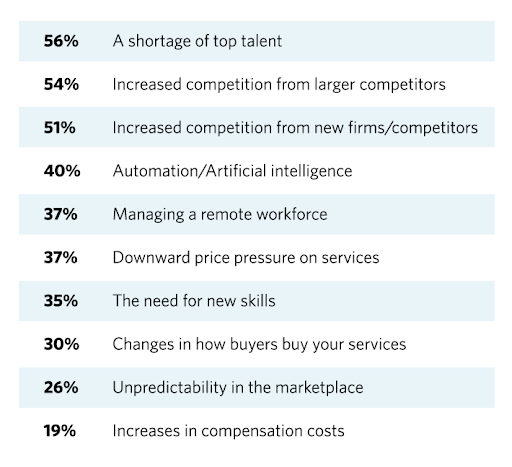Why Your Growth Strategy Should Include These 5 Marketing Practices
By Elizabeth Harr, Hinge

There are admittedly dozens of marketing techniques companies can choose to invest in. Determining which ones deserve a seat at the table alongside your marketing budget requires consideration around your current capital (human and financial), goals for each, and your starting place to see how aggressively you need to get from A to B. In this article, I’ll share findings from our new 2020 High-Growth Study the top five marketing practices that high-growth tech services firms are prioritizing as they chart their path forward to continued high-growth.
First, a definition of high growth. In this study, we consider firms that post 20 percent or more annual growth over a period of at least three consecutive years to be “high-growth”. Our study takes a look at what it takes to deliver this pace of growth organically, year after year.
Second, it’s helpful to understand what high-growth tech firms perceive to be the top challenges they’ll face over the coming years, as the type of marketing they are choosing to prioritize is in direct response to these perceived threats. Below, in descending order, are the top 10 challenges high-growth firms believe they’ll be facing over the next three to five years:

A quick scan of the top perceived challenges shows a level of anxiety (and planning) around competition, multiple issues around talent & skill acquisition, changes in how buyers will buy tech and IT-related services, and the need to incorporate automation/artificial intelligence capabilities.
Next, we’ll take a look at the top five marketing priorities for high-growth tech firms. As I walk you through them, you’ll note a direct relationship to the perceived threats.
Top 5 Marketing Priorities Of High-Growth Tech Firms 2020
- Content Creation: Not so long ago, creating educational content (as opposed to promotional) was enough to help firms stand out from the competition. But things change quickly online, and what used to be exceptional is now a non-negotiable. As more and more firms develop sophisticated content marketing strategies, the demand for high-quality content has risen to a new level. How does content help firms compete? With low barriers to entry, the tech and IT services landscape has become commoditized, and true, differentiated expertise is what often seals the deal. High quality thought leadership promoting that expertise is a more meaningful way to differentiate from the “sea of sameness” – having a passion for excellence, being a trusted advisor, having the best people…you’ve heard them before. Thought leadership also helps attract top talent: it signals you’re a true leader in your space, and subliminally sends the message to a recruit that they too might be groomed as a thought leader. No one wants to be a cog in the wheel.
- SEO: If producing well-written, relevant thought leadership is the #1 priority, ensuring visibility around that content through SEO (search engine optimization) is essential. However, SEO is one of those strategies that can be an expensive investment without much to show for. Not only is Google constantly changing the way it indexes and ranks pages in search results leaving firms unsure of strategic direction, but finding the right keywords is a fluid process, always changing depending audience intent, search volume, and a firm’s ability to rank for certain keywords. That aside, unless content includes keywords, that content remains essentially invisible to the outside world.
- Brand Differentiation: Differentiation is the way in which a business separates itself from other similar firms. Usually, this difference is expressed in the language a contractor uses to describe itself or its services. Particularly in full and open environments, differentiation is essential. But there is more to a differentiator than lip service. It has to meet three criteria. A differentiator must be:
- True
- Relevant
- Provable
And of course, it must be different from most of your competitors.
- Social Media Marketing: Being active on social media is another non-negotiable. Will you win a contract because you’re on LinkedIn? Probably not. But social channels are all part of the visibility-building equation and being absent raises more questions than not. It also plays an important role in a firm’s overall marketing strategy for networking, promotion of thought leadership (not just yours, but other non-competitive sources of content as well), SEO, and recruiting.
- Automation and marketing technology: The time of reckoning is here, and firms can no longer avoid integrating a solid martech stack into their operations and customer management processes. How sophisticated your own martech stack needs to be will depend on what you’re trying to achieve. Are you trying to convert new customers faster with this technology? Are you trying to do a better job of engaging existing customers? Are you trying to learn where prospects and customers spend most of their time? Are you planning to use analytics to predict behavior and conversion rates? Are you simply trying to use data to learn how to communicate better? This is the first year of our study that we’ve seen the adoption of marketing technology in the top five marketing priorities for several segments of professional services, which speaks to the extent to which the right martech stack can help you thrive and stay alive.
What does all of this mean? On the one hand, firms that haven’t traditionally prioritized marketing the high-growth way will have a steep hill to climb in their first several months of learning these habits. On the other, however, the same type of marketing that attracts and wins new business is the same type of marketing that attracts and retains top talent. Firms can certainly find comfort in those synergies and consider investment opportunities accordingly.
About The Author
Elizabeth Harr, Partner at Hinge, is an accomplished entrepreneur and experienced executive with a background in strategic planning, branding, and growth for professional services. Elizabeth co-founded a Microsoft solutions provider company and grew it into a thriving organization that became known for its expertise in Microsoft customer relationship management.
